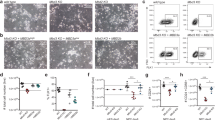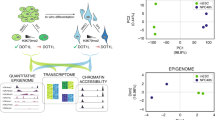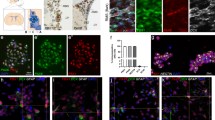Abstract
Differentiation of progenitor cells into post-mitotic neurons requires the engagement of mechanisms by which the repressive effects of the neuronal silencer, RE-1 silencing transcription factor (REST), can be overcome1,2. Previously, we described a high-mobility group (HMG)-containing protein, BRAF35, which is a component of a co-repressor complex that is required for the repression of REST-responsive genes3. Here, we show that the BRAF35 family member inhibitor of BRAF35 (iBRAF) activates REST-responsive genes through the modulation of histone methylation. In contrast to BRAF35, iBRAF expression leads to the abrogation of REST-mediated transcriptional repression and the resultant activation of neuronal-specific genes. Analysis of P19 cells during neuronal differentiation revealed an increased concentration of iBRAF at the promoter of neuronal-specific genes coincident with augmented expression of synapsin, recruitment of the methyltransferase MLL and enhanced trimethylation of histone H3 lysine 4 (H3K4). Importantly, ectopic expression of iBRAF is sufficient to induce neuronal differentiation through recruitment of MLL, resulting in increased histone H3K4 trimethylation and activation of neuronal-specific genes. Moreover, depletion of iBRAF abrogates recruitment of MLL and enhancement of histone H3K4 trimethylation. Together, these results indicate that the HMG-domain protein iBRAF has a key role in the initiation of neuronal differentiation.
This is a preview of subscription content, access via your institution
Access options
Subscribe to this journal
Receive 12 print issues and online access
$209.00 per year
only $17.42 per issue
Buy this article
- Purchase on Springer Link
- Instant access to full article PDF
Prices may be subject to local taxes which are calculated during checkout




Similar content being viewed by others
References
Chen, Z. F., Paquette, A. J. & Anderson D. J. NRSF/REST is required in vivo for repression of multiple neuronal target genes during embryogenesis. Nature Genet. 20, 136–142 (1998).
Ballas, N. et al. Regulation of neuronal traits by a novel transcriptional complex. Neuron 31, 353–365 (2001).
Hakimi, M. et al. A core-BRAF35 complex containing Histone deacetylase mediates repression of neuronal-specific genes. Proc. Natl Acad. Sci. USA 99, 7420–7425 (2002).
Tagoh, H. et al. Dynamic reorganization of chromatin structure and selective DNA demethylation prior to stable enhancer complex formation during differentiation of primary hematopoietic cells in vitro. Blood. 103, 2950–2955 (2004).
Travers, A. A. Priming the nucleosome: a role for HMGB proteins? EMBO Rep. 4, 131–136 (2003).
Lichota, J. & Grasser, K. D. Interaction of maize chromatin-associated HMG proteins with mononucleosomes: role of core and linker histones. Biol. Chem. 384, 1019–1027 (2003).
Reeves, R. & Beckenbauer, L. HMGI/Y proteins: flexible regulators of transcription and chromatin structure. Biochim. Biophys. Acta 1519, 13–29 (2001).
Marmorstein, L. Y. et al. A human BRCA2 complex containing a structural DNA binding component influences cell cycle progression. Cell 104, 247–257 (2001).
Shi Y. et al. Histone demethylation mediated by the nuclear amine oxidase homolog LSD1. Cell 119, 941–953 (2004).
Nishimura, E., Sasaki, K., Maruyama, K., Tsukada, T. & Yamaguchi, K. Decrease in neuron-restrictive silencer factor (NRSF) mRNA levels during differentiation of cultured neuroblastoma cells. Neurosci. Lett. 211, 101–104 (1996).
Milne, T. A. et al. MLL targets SET domain methyltransferase activity to Hox gene promoters. Mol. Cell 10, 1107–1117 (2002).
Nakamura, T. et al. ALL-1 is a histone methyltransferase that assembles a supercomplex of proteins involved in transcriptional regulation. Mol. Cell 10, 1119–1128 (2002).
Morassutti, D. J. et al. Murine embryonic carcinoma-derived neurons survive and mature following transplantation into adult rat striatum. Neuroscience 58, 753–763 (1994).
Bruce, A. W. et al. Genome-wide analysis of repressor element 1 silencing transcription factor/neuron-restrictive silencing factor (REST/NRSF) target genes. Proc. Natl Acad. Sci. USA 101, 10458–10463 (2004).
Olson, J. M. et al. NeuroD2 is necessary for development and survival of central nervous system neurons. Dev. Biol. 234, 174–187 (2001).
Caslini, C., Shilatifard, A., Yang, L. & Hess, J. L. The amino terminus of the mixed lineage leukemia protein (MLL) promotes cell cycle arrest and monocytic differentiation. Proc. Natl Acad. Sci. USA 97, 2797–2802 (2000).
Kanda, S., Tamada, Y., Yoshidome, A., Hayashi, I. & Nishiyama, T. Over-expression of bHLH genes facilitate neural formation of mouse embryonic stem (ES) cells in vitro. Int. J. Dev. Neurosci. 22, 149–156 (2004).
MacPherson, P. A. & McBurney M. W. P19 embryonic carcinoma cells: a source cultured neurons amenable to genetic manipulations. Methods 7, 238–252 (1995).
Paddison, P. J. et al. A resource for large-scale RNAi based screens in mammals. Nature 428, 427–431 (2004).
Acknowledgements
R.S. was funded by a grant from the National Institutes of Health (GM 61204).
Author information
Authors and Affiliations
Corresponding author
Ethics declarations
Competing interests
The authors declare no competing financial interests.
Supplementary information
Supplementary Information
Supplementary figures S1, S2, S3 and S4 (PDF 176 kb)
Rights and permissions
About this article
Cite this article
Wynder, C., Hakimi, MA., Epstein, J. et al. Recruitment of MLL by HMG-domain protein iBRAF promotes neural differentiation. Nat Cell Biol 7, 1113–1117 (2005). https://doi.org/10.1038/ncb1312
Received:
Accepted:
Published:
Issue Date:
DOI: https://doi.org/10.1038/ncb1312
This article is cited by
-
HMG20A was identified as a key enhancer driver associated with DNA damage repair in oral squamous cell carcinomas
BMC Oral Health (2022)
-
HMG20B stabilizes association of LSD1 with GFI1 on chromatin to confer transcription repression and leukemia cell differentiation block
Oncogene (2022)
-
De Novo and Inherited SETD1A Variants in Early-onset Epilepsy
Neuroscience Bulletin (2019)
-
The type 2 diabetes-associated HMG20A gene is mandatory for islet beta cell functional maturity
Cell Death & Disease (2018)
-
Association of recently identified type 2 diabetes gene variants with Gestational Diabetes in Asian Indian population
Molecular Genetics and Genomics (2017)



